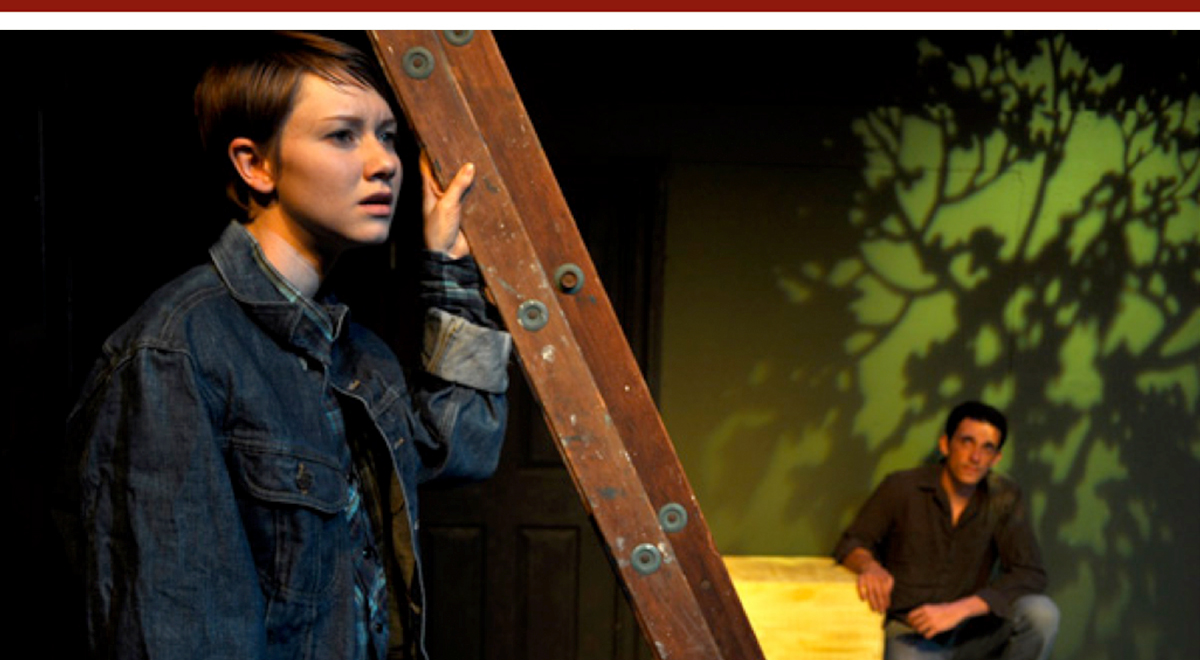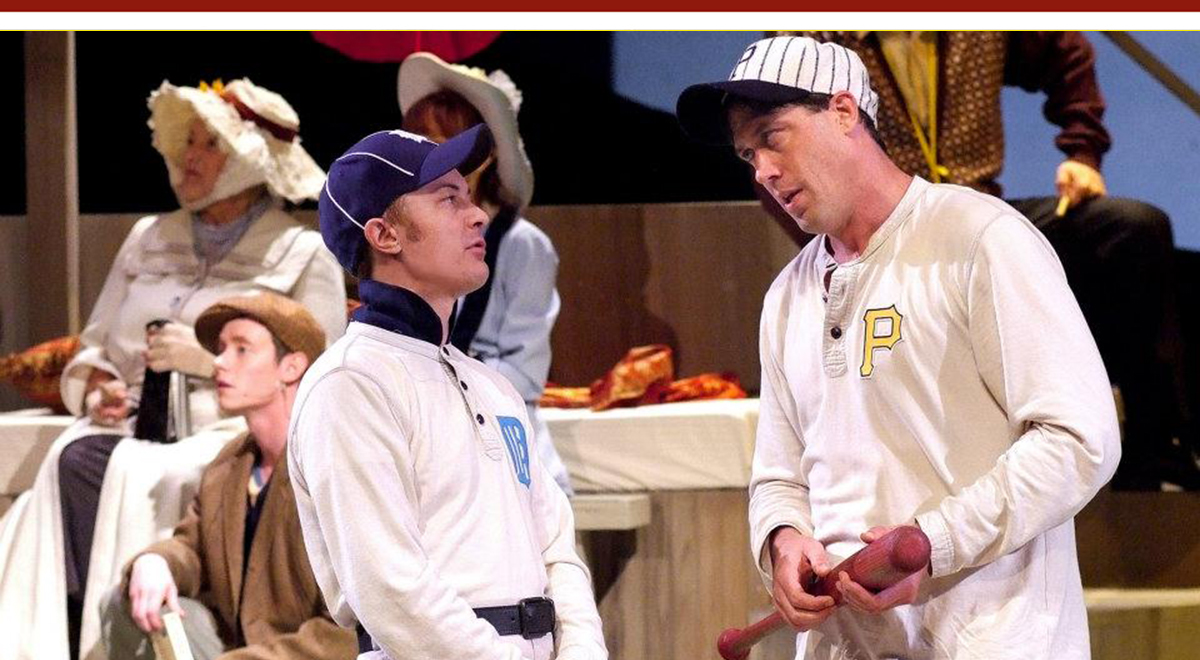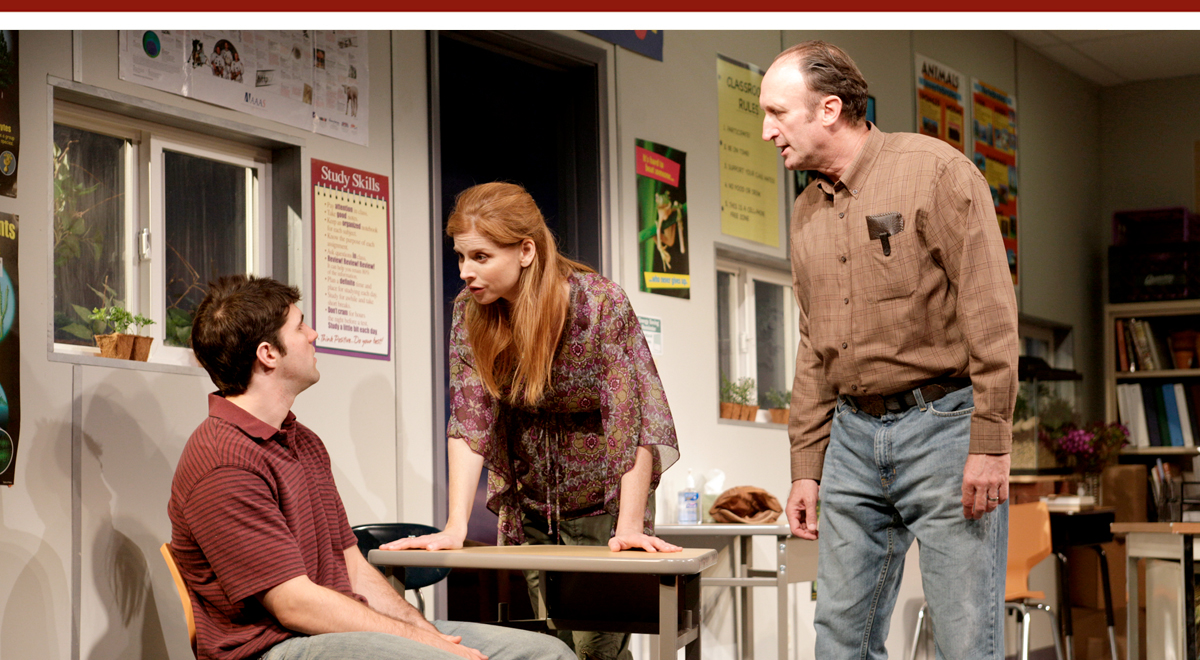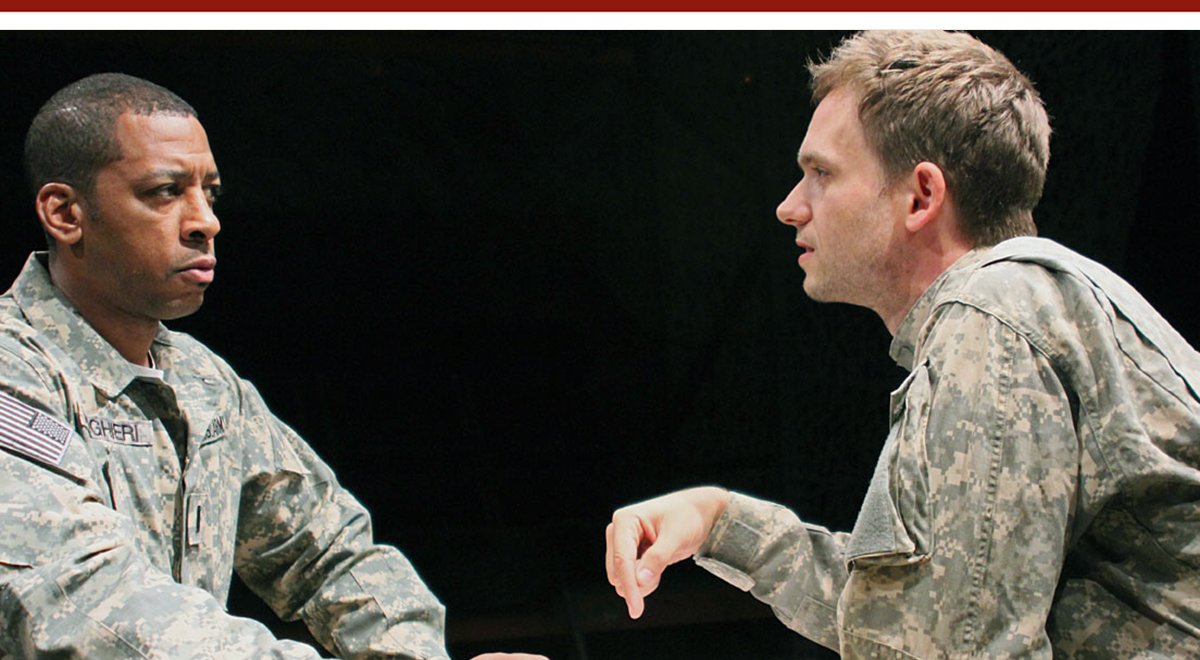OCTOBER 2011
Click title to jump to review
BAKERSFIELD MIST by Stephen Sachs | Fountain Theatre
DOUBLE FALSESHOOD by William Shakespeare and John Fletcher, adapted by Lewis Theobald | Coeurage Theatre Company
HONUS AND ME by Steven Dietz adapted from Dan Gutman's novel | Mainstreet Theatre Company
HOW THE WORLD BEGAN by Catherine Trieschmann | South Coast Repertory
NINE CIRCLES by Bill Cain | Bootleg Theatre
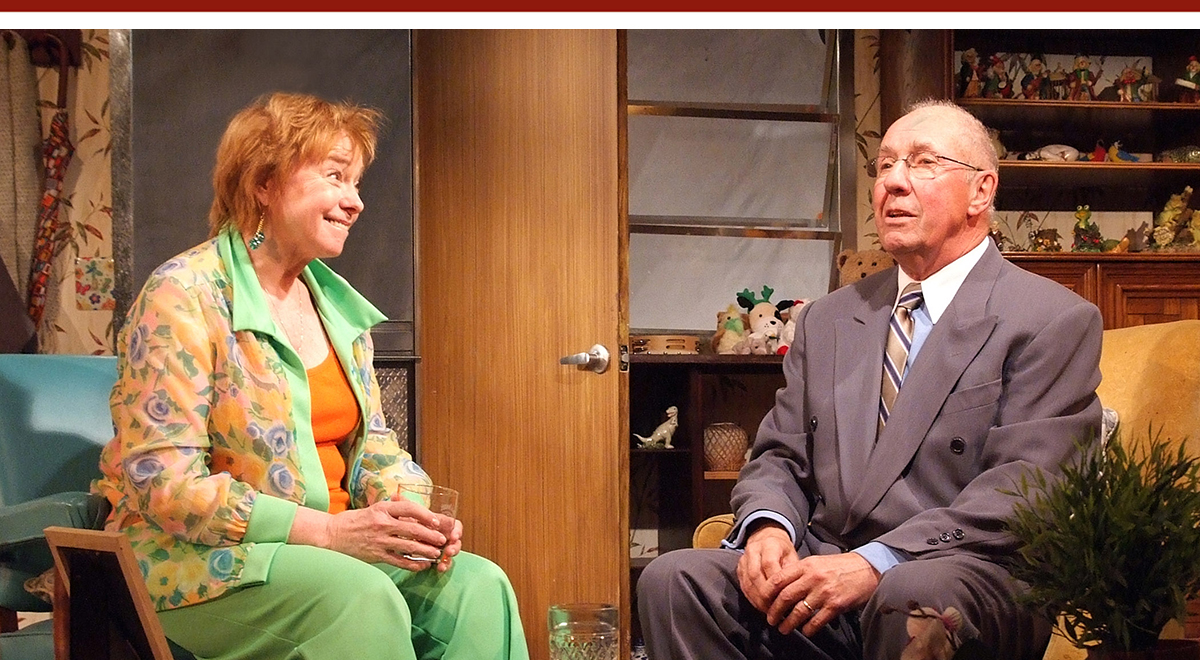
Never mind the Pollocks
Writer-director Stephen Sachs looks at the power of art in his new play, Bakersfield Mist, continuing at Hollywood's Fountain Theatre through December 18. As an International art expert and a collector of clown paintings and chachkes argue the provenance of a $5 Jackson Pollack, we are reminded that the appreciation of art should not depend on whether it appreciates.
Bakersfield Mist is inspired by the true story of Teri Horton, the 73-year-old Costa Mesa woman who bought a $5 abstract painting at a thrift shop thinking it might brighten one of her bare walls. When it turned out to be too large, it went into a yard sale where a passing high school art teacher said it resembled Pollack’s work, notably his 1950 painting 'Lavender Mist.' The chance that this dropcloth on stretchers could be worth millions got her studying, soliciting the opinions of authenticators, and eventually working her way up the media ladder to a "60 Minutes" segment and a 2006 documentary.
Sachs’ play is not a documentary, although it borrows details from Horton’s saga, such as considering the painting for rifle practice, declining millions of dollars from a foreign art lover in hopes of getting much more, and pursuing authentication despite unanimous dismissal by the experts she attracts.
The play opens with Maude Gutman (Jenny O’Hara), a laid-off bartender, preparing the disputed canvas for a viewing by Lionel Percy (Nick Ullett), who is on his way from New York. He is her latest last hope after the previous appraisers failed to raise its value above the $5 she had paid. That a large canvas by a major painter would cross the country unnoticed is unlikely, but not impossible. And Gutman is desperate for a windfall to turn around her meaningless life. She gets Percy to tell her than an authentic Pollock could fetch as much as $100 million. But this, he assures her, is not painted by Pollock.
Gutman berates Percy into extending his stay through the afternoon, softening his resolve with some surprising documented evidence and a steady stream of Johnny Walker. By the time Ken Booth's dusk cue glows in the windows of Jeff McLaughlin's elaborately cluttered mobile home set, Percy is done. His decision is final, he says, and rides off into the sunset.
The play veers between high comedy and low. O’Hara and Ullett, who are married, have obvious chemistry and enough talent to create authentic characters we care about, or slapstick foils who dissolve into caricatures. Occassionally, O'Hara's fondness for screwing up her face in mood-breaking grasps at laughs, seem to undermine her sympathetic portrayal, While the one-act, 90-minute play's action is limited and circular, face-acting never provides sustenance. These two entrenched people can change only minimally over the course of an afternoon. But Sachs has provided some good writing here, and there are plenty of personal revelations from each to carry the day.
In addition to good writing and a respectful variation on a real event, there is a message that transcends Pollock, and even painting. It surely heartens the hardcore theater aficianados scattered among the Fountain's seats: value art that affects you personally, even if you are in a shrinking minority.
Shon LeBlanc’s single costume per character do well to establish them. And Peter Bayne adds the sound design, which includes pre-show country music program from a Bakersfield radio station that ends with the necessary announcements about exit locations and electronic devices.
top of page
BAKERSFIELD MIST
written and directed by STEPHEN SACHS
FOUNTAIN THEATRE
October 21-November 12, 2011, 2011
Opened 10/21, rev’d 10/28
CAST Jenny O’Hara, Nick Ullett
PRODUCTION Jeff McLaughlin, set; Shon LeBlanc, costumes; Ken Booth, lights; Peter Bayne, sound; Terri Roberts, stage management
HISTORY Produced by Simon Levy and Deborah Lawlor. A Rolling World Premiere presented by the Fountain Theatre and the National New Play Network.
Jenny O’Hara and Nick Ullett
Ed Krieger
Thrown for a loss
As awareness of the Shakespeare authorship controversy gets unprecedented exposure with the October 28 release of Sony Pictures’ Anonymous [more]), another authorship debate is getting a quieter theatrical airing in Coeurage Theatre Company’s staging of Double Falsehood, or The Distrest Lovers (at the Actors Center Theatre through November 6).
Some scholars believe that Shakespeare not only wrote the plays in his official canon, he wrote or co-wrote one or more additional works. Though some of these texts survive, they are collectively known as his "lost plays." Double Falsehood, one of the top candidates for canon inclusion, was "found" when 18th Century theater impresario Lewis Theobald obtained three imperfect copies of it. Theobald merged the three into one, producing it in 1727. The editor of the Arden Shakespeare collection, which has included Double Falsehood, told the BBC's World Service, "I think Shakespeare's hand can be discerned in Act One, Act Two and probably the first two scenes in Act Three of the play."
The current staging by Coeurage, however, makes one wonder if the play was "lost," or tossed. The production can be excused its poor-theater staging, the plays were written for the bare stage. But Shakespeare eschewed scenery with the thought the performances would create the world. Here, the lack of a dynamic central performance and less-than-compelling acting elsewhere is a bigger problem. This is a language most dense, thicket’d with over-ripe phrases that strain syntax. For example, in the first exchange, a son tells his dad he's sad. (An "unwonted Strain Visits my Heart with Sadness.") His father responds with speech only a Filibusterer could love:
Why, my son?
Making my Death familiar to my Tongue
Digs not my Grave one Jot before the Date.
I've worn the Garland of my Honours long,
And would not leave it withere'd to thy Brow,
But flourishing and green; worthy the Man,
Who, with my Dukedoms, heirs my better Glories.
Again, a theater brave enough to make every performance "pay what you will," will always be forgiven a costume budget that only affords Erik McEwen's contemporary dress. Joe Calarco’s sound design not only helps distinguish the town setting from the country, with vocal jazz and country music, respectively, it supports the costuming with mid-20th Century tunes. But while these choices help establish the production setting, they just further the alien-ness of what issues, uncomfortably, from of the actors' mouths.
The source material for Double Falsehood seems to be Cervantes’ Don Quixote, which had its English-language debut in 1612, the year before a play entitled The History of Cardenio premiered at the Globe. While no copy of that play survives, a 1653 entry in the Stationer’s Registry credits Shakespeare and John Fletcher as the authors. It is Theobald’s contention that his Double Falsehood is a renamed adaptation of that.
In Cervantes' novel, Cardenio tells Quixote and his servant the sad tale of his betrayal by the Duke’s second son. In the play, Cardenio is Julio (Peter Weidman), and moves out of the narrator role to become one of the characters caught up in the falsehoods of that conniving younger son, now named Henriquez (Jeremy Lelliott). Henriquez sends his friend Julio to request aid from the Duke (Alexander Wells) and older brother Roderick (Michael Yurchak). While Julio is away, Henriquez, fresh from the rape of Violente (Valorie Curry), a local girl who wanted none of him, makes moves on Julio's betrothed, Leonora (Sammi Smith). Meanwhile, Julio seeks the approval of his parent (father Camillo in the script, mother Camilla here, played by Nicole Farmer, with Mary Jo Kirwan on for her at this performance). Eventually, Henriquez' machinations will catch up with him, thanks in part to some good old Elizabethan girl-disguised-as-boy deception by Violante. Other members of the ensemble are Amine El Gamal and Dennis Gersten.
There are some bright spots in Curry, Yurchac, and Smith. Director Kirsten Kuiken has an ungainly plot to wield about the tiny stage, and little more than overstuffed dialogue with which to wield it. Being true to the text was the first priority. With few exceptions, there justaren't enough dramatics in her drama. Weidman, who was part Coeurage’s excellent production of LaBute’s Bash earlier this year, has his moments, but he is required to be a passive figure for most of the play. This production is a noble effort and, with Coeurage's unique mission to admit everyone at whatever price they can afford, it remains a company that deserves special attention.
top of page
DOUBLE FALSEHOOD
by WILLIAM SHAKESPEARE
and JOHN FLETCHER
adapted by LEWIS THEOBALD
directed by KIRSTEN KUIKEN
COEURAGE THEATRE COMPANY
September 30-November 6, 2011
(Opened, rev’d 10/7)
CAST Valorie Curry, Amin El Gamal, Nicole Farmer, Dennis Gersten, Jeremy Lelliott, Sammi Smith, Peter Weidman, Alexander Wells, Michael Yurchak u/s Lindsay Evans, Mary Jo Kirwan, John Klopping, TJ Marchbank
PRODUCTION Jenna Fletcher, set; Erik McEwen, costumes; Michelle Stann, lights/stage management; Gregory Nabours, music; Joe Calarco, sound; TJ Marchbank, fights; Lawrence Peters, dramaturg
HISTORY Listed as performed by The Kings Men at London’s Globe in 1613, and appearing in the Stationer’s Register in 1653 as written by William Shakespeare and John Fletcher. Subsequently attributed with reservations by many scholars. Lewis Theobald claims to have found three versions and, in 1723, created this adaptation from them.
Valorie Curry and Peter Wiedman
Ric Perez-Selsky
Double header
Baseball and theater have qualities that qualify them as secular religions. Steeped in tradition, they provide impressive venues for congregating, and at their best create a bond between generations in being passed from one to the next. Fans of each often attend into old age because of a devotion acquired in childhood.
Playwright Steven Dietz’ 2005 adaptation of Dan Gutman’s 1997 Baseball Card Adventure Honus and Me brings these two worlds together. The production by MainStreet Theatre Company at the Lewis Family Playhouse (in Rancho Cucamonga’s Victoria Gardens through October 16) is an opportunity for adults to share the joys of both art and sport in an entertaining 75-minute show. Weekday performances are for bused-in grade school classes: Weekends are for families.
While theater for young audiences may be the minor leagues, Director Abigail Deser’s cast of seven are accomplished pros. Though their feet may not reach the floor, the children in the audience certainly grasp what makes theater unique. The story is clear, the relationships real, and the physical production is designed by some of the region's best. Tom Buderwitz’s set, under Tom Ontiveros' warm lighting, provides the proceedings with the glow of nostalgia. A "grass" baseball field and "dirt" batter’s box are raked below a half-dozen blow-ups of famous baseball cards. Tina Haatainen-Jones’ contemporary and period costumes facilitate a constant string of quick changes for most cast members' multiple roles. Lindsay Jones provided original music and sound.
The young audience won't appreciate the finer points of running stagecraft while watching the show. However, appreciation of the technical wizardry comes during a post-show Q&A in which they get to ask the actors "Is that really grass?" and "How did the bedroom change to a hotel" to be answered.
The Honus of the title, pronounced HAHN-us as in the Dutch name "Johannes," is Johannes Peter Wagner, a superstar during 21 major league seasons in the early 20th Century. A shortstop for the Pittsburgh Pirates who batted over .300 for 17 seasons, it is his baseball card that now makes him famous. One of the many fascinating facts woven into the script is why less than 40 cards exist today. Wagner objected to having his picture used to sell tobacco (which is the product that carried the cards) and halted all printing after a first run. According to the play, a card has been auctioned for as much as $2.8 million.
Joey (Kevin Stidham) is an obsessive baseball fan whose usual contribution to his Little League team is a game-ending strikeout. While his coach (Thomas Fiscella) finds it hard to encourage Joey, his divorced parents (Ann Marie Lee and Matt Foyer) usually attend to provide a supportive "You’ll get a hit next time." An ancient neighbor, Miss Young (Jayne Taini), offers him $10 to clean 90 years of junk from her attic. He is told he may keep anything he fancies and discovers one of Wagner’s precious cards. How to handle moral challenges is a regular feature in theater for young audiences, and Joey's dilemma provides an area of concern as gray as Wagner's old uniform. Will Joey offer Miss Young the option of taking back the card? Or will he sell it and end his single mom's long shifts at the hospital?
Before this is resolved, the card becomes a magical connection to Wagner’s era and the slugger is pulled from a game and into Joey’s bedroom. Though he does not know how he has landed, Wagner (Cory Lyman) soon accepts being in 2011 with his century-old uniform and bat. He becomes a baseball big brother, giving Joey batting tips and life coaching before convincing his young friend to tumble back in time with him. Together they face off with Detroit Tiger legend Ty Cobb (Jacob Sidney) in a World Series showdown.
The cast also includes Matthew Henerson in several roles, including a nasty trading card shop owner who vows to get Joey’s card by any means necessary. Henerson is a great villain, a big, bald-headed bad guy who the kids appreciated for his realistically cartoony creation. Among the other standouts are Lee as an endearing voice of doing the right thing, Lyman and Sidney as good ol' baseball players, and Stidham, who deserves extra credit for driving the show.
It’s a lot of fun that delivers its engaging baseball lore through the magic of theater. Baseball and theater both have their unforgettable plays. For some youngsters in attendance, this will surely be one of those.
top of page
HONUS AND ME
by STEVEN DIETZ
adapted from the novel by DAN GUTMAN
directed by ABIGAIL DESER
MAINSTREET THEATRE COMPANY
at the Lewis Family Playhouse
October 1-16, 2011, rev’d 10/11)
CAST Thomas Fiscella, Matt Foyer, Matthew Henerson, Ann Marie Lee, Cody Lyman, Jacob Sidney, Kevin Stidham, Jayne Taini
PRODUCTION Tom Buderwitz; Tina Haatainen-Jones, costumes; Tom Ontiveros, lights; Lindsay Jones, music/sound; Julie Haber, stage management
Jacob Sidney and Cody Lyman
Ed Krieger
How the play began
The title of Catherine Trieschmann’s How the World Began may suggest the certainty of a college syllabus, but this replication of the head-butting debate over the earth’s origins is an intellectual stalemate that stalls the play's action. In its debut, at South Coast Repertory through October 16 in association with Women’s Project Theater, the developing script will need to better develop the characters it has created or risk extinction.
Each side in the battle over the beginning of human life, whether it's about the species as a whole or each new conception, sees itself as a light against the forces of darkness. One side defends God’s word and the other defends physical evidence and scientific study. Trieschmann and director Daniella Topol do not expect to soften either side’s stance in this hour-and-40-minute one-act. Instead, the issue is backdrop for a look at some sympathetic characters who are caught in its latest battleground, public education.
Science teacher Susan Pierce (Sarah Rafferty), a recent university graduate yet to earn her teaching credential, has left New York City for Plainview, Kansas. She wants to launch her career as she helps the town rebuild after a recent killer tornado. With the play set "In the present," a recent grad would be well aware that between 1999 and 2007, Kansas was the epicenter of a political tug-of-war over how science curricula would approach evolution. At the close of the 20th Century, the Kansas Board of Education removed all references to "biological macroevolution" of the earth from science education standards, which allowed local school districts to stop teaching evolution. In 2001, another political shift returned evolution to a requirement until a shift three years later produced a series of evolution hearings. That led to new "science standards that require critical analysis of evolution – including scientific evidence refuting the theory." This held for two years, until moderate Republications brought about the removal of references to Intelligent Design as part of science.
Despite that highly publicized rancor, Pierce jabs the open wound in one of her first lectures, calling "non-scientific" explanations of the earth’s origins "gobbledegook." While it may be the appropriate, even admirable view for a science classroom, it’s asking for trouble in a Kansas classroom. It also seems particularly insensitive from someone arriving to help heal the community.
One of Pierce's students, Micah Staab (Jarrett Sleeper) is extremely distressed by her characterization of Christian creationism. For murky psychological reasons rooted in his relationships with a deceased mother, father, and stepfather, Staab’s opinions are intractable to the level of insufferable. The dramatic action quickly hits a wall that, as it stands, Treischmann cannot break through.
Staab first must get Pierce to admit she actually said "qobbledegook." This takes some time and requires the help of Micah’s unofficial guardian, Gene Dinkel (Time Winters), who brings Pierce a pie peace offering. When he is unable to get her to confess, Dinkel threatens to turn the community against her. Once Pierce admits the indescretion, she then is hounded by Micah to apologize to him. This takes more time, and once it is accomplished he ratchets up the demands for an apology to the class, and then to the entire town. (The way things were going, with more time, Micah might have brought the houselights up and wrestled another apology from her for the audience.)
Treischmann's big stumbling block is that her least favorite character is the one she's invested the most care in creating. Sure, Pierce is lovely, committed, pregnant. But her past life – and why the father of her baby "won't be joining her" – seem to want clarity. The myopic Micah's dysfunctional upbringing has left an irrational fear of Divine retribution, which he believes was responsible for the recent tornado and is behind his pursuit of Pierce's mea culpa. Topol requires Sleeper to remain in a constant state of duress. The justification is that he must maintain a hair-trigger state of distress that will send him under a table anytime a siren goes off. This manifestation of the God-fearing lad's fear helps Pierce understand the stakes. On the other hand, he's a highly intelligent kid, with a talent for cagey interrogating that rivals William F. Buckley. It seems possible that the play might even work better with a less neurotic Staab.
Rafferty provides good insights into this first creation of Pierce, not the least of which comes from the fact that the actress, like her character, is five months pregnant. Winters is so good that he almost covers up Dingle's unjustified shift from bullying protector of his ward to agent of reason willing to ease the town’s requirements for Pierce’s apology.
Sara Ryung Clement’s detailed schoolroom set, against a full-stage cyclorama sky lit beautifully by Paul Whitaker, gives the play needed realism, as does Clement's costumes, and Darran L. West's music and sound design.
top of page
HOW THE WORLD BEGAN
by CATHERINE TRIESCHMANN
directed by DANIELLA TOPOL
SOUTH COAST REPERTORY
September 25-October 16, 2011
Opened 9/30; rev’d 10/8m
CAST Sarah Rafferty, Jarrett Sleeper, Time Winters
PRODUCTION Sara Ryung Clement, set/costumes; Paul Whitaker, lights; Darron L. West, music/sound, Kelly L. Miller, dramaturg; Jennifer Ellen Butler, stage management
HISTORY Originally commissioned by the Manhattan Theatre Club with funds from Alfred Sloan Foundation. Produced in association with the Women’s Project Theater. Honorary Producers, Bette and Wylie Aitken World Premiere
Jarrett Sleeper, Sarah Rafferty and Time Winters
Henry DiRocco
Infernal Iraq
In Equivocation [review], playwright Bill Cain had playwright Bill Shakespeare reluctantly construct a plot around a recent event – in that case the Gunpowder Plot of 1605. Now Cain bases his follow-up, Nine Circles, on an incident in 2006 where U.S. soldiers brutally attacked a 14-year-old Iraqi girl and her family.
Cain uses the horrific event, in which soldiers raped the girl before burning her and murdering two family members, to springboard into the kind of theatrical fireworks that make his work stand out. Using unforgivable cruelty as the starting point, he follows a soldier lost in the double standards of war. As the accused Reese proceeds through military justice to conviction and execution, he regains the vision to distinguish combat killing from war crime. We watch him spiraling down into damnation as he simultaneously gains a higher perspective. This duality is illuminated by Cain's invocation of Dante Alighieri’s monumental 13th Century masterpiece, The Divine Comedy. It is in one of this work's three books, Inferno, that the use of the nine circles is found.
For the play's Los Angeles premiere, at the Bootleg Theater (through November 12), director Jason Zsebe's acting squad is led by Patrick J. Adams, a veteran of Equivocation who is a co-producer. Set designer Jason Adams has turned the Bootleg's flexible space into the center ring of a big top, surrounded by four double-decked seating galleries. (Upper seats are accessed by ladders.)
In 2006, Specialist James Barker led three companians in lengthy rounds of drinking and cards that devolved into the attack on the civilians. He was charged and pled guilty, providing information about his co-defendants to reduce a sure death sentence to a 90-year prison sentence. [Read more.] In Nine Circles, ringleader Reese (Adams) maintains his silence to protect his fellow defendants, while they ultimately turn on him, heightening the alienation that helps propel him into Dante's eternity of self-examination and retribution. Reese’s loyalty to his comrades and adherance to a code that disappears under pressure, provides added tension as he approaches his death by lethal injection.
The play is structured in nine scenes, introduced by an actor as set pieces are reset, from Reese’s ‘honorable discharge’ to his ‘execution.’ In the first scene, he seems bewildered by the discharge administered by his senior officer (Joe Holt). He clearly feels he belongs in the military. In the second scene, he is arrested, but does not recall the crime with which he is charged. Through the subsequent 'circles,' he regains the memory in a combination of alcohol haze and denial. Helping with his recollection and then his defense are a series of visitors played by Holt, Arlene Santana and Paul Dillon.
There is an obvious contradiction for Reese in his crime. Looking at it from outside the circle, as we do, we understand the distinctions between fighting combatants and murdering civilians – whether they seem innocent to him or not. But as he says back in the States, "Everything we did over there is illegal over here." Another character poses another irony: to avenge the 3000 deaths on September 11, 2001, 5,000 soldiers were sacrificed.
Cain is one of the most exciting writers working in theater today. He tackles sprawling concepts with an eye toward their immediate relevance and an ear for speech that is rich and moves the story. It is a massive amount of investigation packed in its 100-minute one-act production. Sometimes, the arguments feel as circular as the set design, and this can become irritating when entire sections are delivered, for long stretches, at the highest volume without modulation. But, in the closing moments, as Reese descends into the excruciating final circle, the image created by Cain, Zsebe and Adams, of simultaneous transcendence and damnation, is one of the year's most searing and unforgettable.
Holt, Santana and Dillon give solid support, engaging in a series of fierce, two-person scenes. The design team of Kathryn Poppen (costumes), Lap Chi Chu (lights) and Adam Phalen (sound) heighten the realism and drama of this pressure-cooker experience. If it errs on sustained intensity that compromises some of the potential nuance, well, maybe that's part of the message.
And if it weren't enough that Adams gives each performance the energy of a combat mission, and helped produce the show, he contributed the program cover design: a simple close up of an eye. Like the play, we see both a pupil surounded by lively patterns, and a bottomless black hole at the center of circles.
top of page
NINE CIRCLES
by BILL CAIN
directed by JUSTIN ZSEBE
BOOTLEG THEATRE
October 21-November 12, 2011
(extended to 11/19)
Opened 10/21, rev’d 10/28
CAST Patrick J. Adams, Paul Dillon, Joe Holt, Arlene Santana
PRODUCTION Jason Adams, set; Kathryn Poppen, costumes; Lap Chi Chu, lights; Adam Phalen, sound; Amber Koehler, stage management
HISTORY Winner of the 2010 Sky Cooper New American Play Prize at Marin Theatre Company, where it received its world premiere. Developed at Ojai Playwrights Conference and the Pacific Playwrights Festival (SCR). Los Angeles Premiere


